Current as of: March 29, 2025 - 20:06
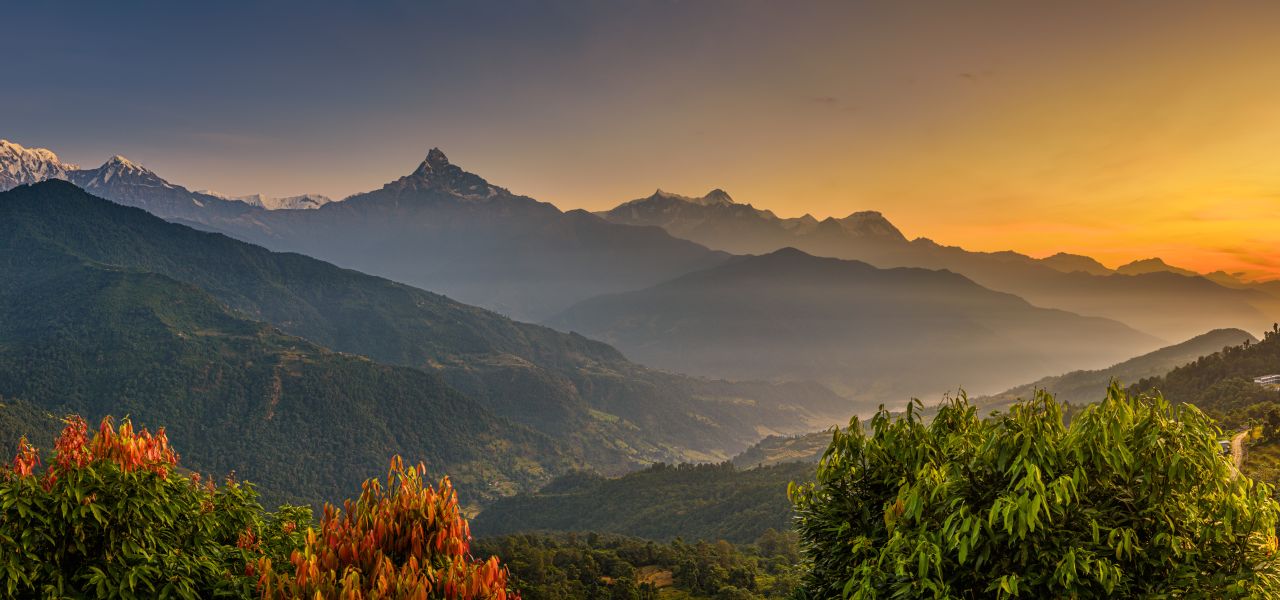
Annapurna to Chitwan: Walks & Wildlife Trip Notes
- Ways to Travel: Guided Group
- Destination: Nepal
- Programmes: Walking & Trekking, Wildlife
-
Activity Level:
3 out of 7 - Moderate
- 13 Days: Land Only
- Ages: 16+
- Trip Code: TNH
- Carbon Footprint: 26kg CO2e
Trip Overview
Enjoy two Nepal adventures in one trip: walk among iconic Himalayan mountains and safari with an expert naturalist
One trip, two of the great adventure experiences in Nepal: walking in the Annapurna foothills and wildlife watching in Chitwan. The trekking portion of our adventure is the ideal introduction to walking in the Himalaya, staying at low altitude with spectacular views throughout. After, we experience another side of Nepal by going in search of roaming wildlife at Chitwan National Park. With the help of an expert naturalist, we explore the home of the one-horned rhino, while also spotting birds, crocodiles, boars and deer.
Why trek with Exodus?
- More than 30 years’ experience organising treks in Nepal
- Exodus annually commissions independent air-safety audits on domestic carriers in Nepal and only use those approved as part of the audit
- Experienced English-speaking local leaders who are qualified in first aid
- All staff (leaders, guides and porters) are fully insured and paid a fair wage
- Speak to Exodus office staff who have done the trek themselves
At a Glance
- Accommodation: 7 Superior nights (5 mountain lodge, 2 jungle lodge), 3 Classic nights (hotel)
- Travel by air-conditioned private bus and one internal flight
- Six days of walking with full porterage
- Low altitude throughout, maximum reached: 6,601ft/2,012m
- Small group size (maximum 16). Minimum age: 16
Highlights
- Combine a multi-day trek in the Annapurna foothills with wildlife watching in Chitwan
- Stay in some of the best mountain lodges in the Himalaya with views of iconic peaks
- Unwind after our trek with a stay in the lakeside city of Pokhara
- Visit a Tibetan refugee village and learn how to make traditional momo dumplings
- Game drive through Chitwan National Park with an expert naturalist
- Ride a dugout canoe down the Rapti River in search of crocodiles
Is This Trip for You?
This trip has been graded Activity Level 3 (Moderate). For more information on our trip gradings, visit the Activity Level Guidelines page. If you have any queries about the difficulty of the trip, please contact us.
Walking routes and fitness: Our six-day Annapurna hike is a great introduction to Himalayan trekking with full porterage throughout, so you need only carry a backpack. There are three to five hours of walking on most days. You need fairly decent fitness levels, as there are quite a few steep uphill walks and some quite long descents (two to three hours). Many of the trails consist of stone steps.
Accommodation: The lodges used during your trek offer the highest level of comfort in the Himalaya and are luxurious compared to the teahouses.
Nepal flight safety: Many of our treks in Nepal use domestic flights to reach the trekking areas. The mountainous Nepalese terrain is subject to changeable weather, which makes flying conditions complex and challenging, and unfortunately there are significantly more incidents here than in other countries, including fatalities. The EU highlighted the poor safety record in Nepal in 2013 by including all Nepalese-registered airlines on the EU banned list, which prevents them from flying in EU airspace. While no Nepalese-registered airlines currently fly within the EU, the EU instigated this ban to highlight the risk of flying in Nepal to EU citizens. These airlines are unlikely to be members of internationally recognised safety audit systems and the Civil Aviation Authority (CAA) of Nepal does not operate to the same standards as those of Western nations.
Flying within Nepal is therefore a known risk, and we strongly encourage you to consider this carefully before booking. We suggest you refer to the following sources:
- The current travel advice for Nepal issued by the UK Foreign, Commonwealth and Development Office
- The Air Safety Network entry for Nepal
In response to concerns over this safety record, Exodus arranges for independent air-safety auditors to visit Nepal annually to assess the suitability of the available carriers. We then restrict our use to only those approved as part of this audit. In emergency situations, we will need to use helicopters, so we also have a list of approved helicopter carriers. Should concerns arise regarding the safety of an airline on our approved list, we will remove the carrier from the list immediately, and it would only be reinstated once our air-safety auditors are confident the airline meets acceptable safety standards.
We appreciate you may have concerns about flying within Nepal, so we ask that you consider all the information above when deciding to book this trip.
Group
The group is generally between four and 16 people.
All departures have an English-speaking Nepali tour leader throughout. All Exodus tour leaders are highly experienced and have undertaken Exodus leader training courses and wilderness first-aid training. The trekking guides are licensed by the Trekking Agencies’ Association of Nepal (TAAN) and receive additional training through Exodus.
The leaders are assisted by additional guides (where necessary) and there is one porter for every two passengers to carry the trek packs. All your main gear is carried for you, and you only need to carry whatever you require for that day’s trek.
Adult min age: 16
Min group size: 4
Max group size: 16
Itinerary
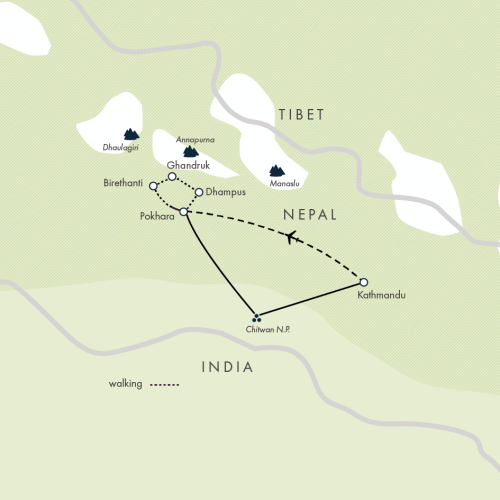
Land Only
- Start City: Kathmandu
- End City: Kathmandu
Land Only Itinerary
The group flights depart London today. The group flight may vary from one departure date to another but generally, it is an overnight flight departing in the evening and arriving the next day.
The tour starts at the Royal Singi in Kathmandu. If you have free time after arrival, you may want to relax into the adventure with a drink at the rooftop bar, enjoying 360-degree views from the sun terrace over Kathmandu valley.
There is a full trip briefing this evening with your tour leader, in which we gather as a group for the first time and get to know each other a little.
Accommodation: Royal Singi (or similar)
Take a 30-minute flight to Pokhara this morning, bypassing a long, bumpy, drive and maximising our time in the Himalaya. On a clear day, we get magnificent views of those same mountains from the right side of the plane.
From the airport, we first head to the hotel in Pokhara to collect our trek packs and meet the guide for the trek briefing. After, leaving any luggage you don’t wish to take on trek at the Pokhara hotel, we take a short transfer to our trek start point: the village of Nayapul.
We begin by following a ridgeline in the lower Annapurna foothills with views of the Pokhara Valley. The route then drops to the Modi River Valley, where Sanctuary Lodge is located. The property has magnificent views of the sacred and unclimbed Fishtail Mountain (or Machhapuchhare, as it is locally known).
Lunch is in the lodge; in the afternoon, we can either relax in the wonderful garden or join the tour leader on a bird-watching walk to Birethanti village.
Accommodation: Sanctuary Lodge (3,363ft/1,025m)
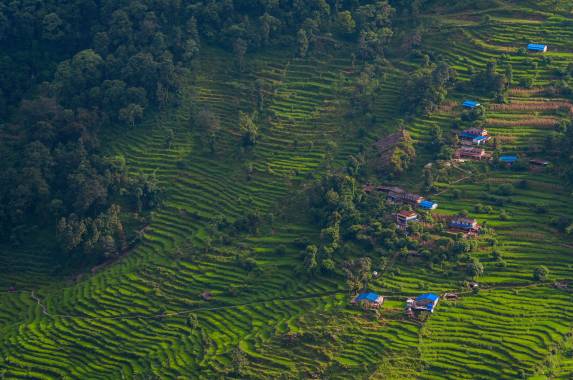
Leave the lodge after breakfast to start today’s trek through small farms. Following the Modi River, and with constant views of Annapurna South and Machhapuchhare ahead, we soon climb the valley towards the mountains.
Today is quite a long climb up stone steps, passing through rice fields and forest, but we take plenty of stops and have lunch en route. In the afternoon, we arrive at Himalaya Lodge in Ghandruk. Enjoy tea and snacks on arrival, plus spectacular views of Annapurna South, Hiunchuli and Machhapuchhare.
Accommodation: Himalaya Lodge (6,601ft/2,012m)
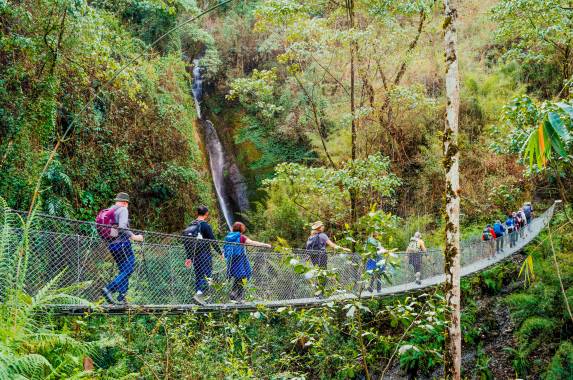
Although we can see our next destination Landruk village across the valley, we must descend steeply to the river and climb up the other side to get there. Crossing the suspension bridge, trek up a stone staircase to Landruk, enjoying views of the Annapurna range and passing under the cliffs where honey hunters climb ropes to harvest wild bee honey.
Lunch is ready as we arrive at our lodge. After, rest and enjoy the spectacular views of Annapurna South and Hiunchuli or go on a sightseeing tour in the village with your guide.
Accommodation: La Bee Lodge (5,135ft/1,565m)
It’s an easier walk today on a wide trail with no steep ups or downs, passing through village and farmlands with views of the Annapurnas behind. Today is a great day for bird watching in the forests above us. We arrive at the lodge by lunchtime; in the afternoon, enjoy mountain views from your room or spend time in the wonderful garden with views of Annapurna South. There is also the option of a guided walk to Thanchok, a traditional Gurung village. Occasionally, if Gurung Lodge is full, we walk on for another 20 minutes to the equally wonderful Mala Lodge in Tomijun village.
Accommodation: Gurung/Mala Lodge (4,593ft/1,400m)
After a spectacular sunrise on Annapurna South, walk along a wide forest track ascending gradually for a couple of hours. A short section on a forest trail brings us to the main trail at Potana. Half an hour further on, we come to Australia Camp, a collection of lodges with panoramic views of Machhapuchhare, Lamjung Himal and Manaslu. We can stop here for a tea break before descending the ridge to Dhampus. Enjoy a hot lunch at the lodge, after which you can take a short walk into Dhampus village. The sunset and sunrise from the lodge garden are not to be missed – we can see all the way to Annapurna South, Hiunchuli, Machhapuchhare, Annapurnas 4 and 2, Lamjung Himal and Manaslu.
Accommodation: Dhampus/Basanta Lodge (5,003ft/1,525m)
Depart along the ridge after breakfast and descend on a stone staircase through the wooded hillside and terraced farmland. After 90 minutes to two hours, we reach the valley floor: the end of our hiking adventure in the Annapurna foothills.
We transfer (one hour) to Pokhara, a lakeside city that’s become a hub for adventurers tackling the Annapurna trails. Having just completed a multi-day hike, the afternoon is free for you to relax. You may want to chill by the hotel or wander along the lakeside browsing the shops. Alternatively, take a boat ride on Phewa Lake or hire a bike for a cycle along the lakeshore. Your tour leader will brief you on the various options available.
Accommodation: Hotel Pokhara Village (or similar)
Head to the Tibetan refugee camp in Tashiling this morning, a 15-minute drive out of Pokhara. Established in the 1960s, when hundreds of Tibetans fled instability in their home region, the Tashiling camp is now a permanent home to around 100 families. Meet some of the residents and take part in a cookery experience, learning how to make the popular Nepalese snack momos, which originated from Tibet and was introduced to Nepal by the refugees. Before leaving, look around the carpet handicraft centre, souvenir shops and traditional Tibetan food shops with any purchases directly supporting the community.
We also have an optional visit to the International Mountain Museum in the afternoon, which delves deep into the history of mountaineering across the planet, or perhaps take the chance for a boat trip on the lake if you didn’t yesterday.
Accommodation: Hotel Pokhara Village (or similar)
We leave Pokhara this morning (with magnificent Annapurna views on clear days) and embark on a four to five-hour drive to Chitwan. Along the way, we are accompanied, in parts, by the Marsyangdi and Trishuli rivers. The road heads towards Kathmandu for about 56mi (90km) before turning south to Chitwan National Park.
We should arrive around lunchtime; this afternoon, we meet our naturalist guide who discusses the activities for the next two days, followed by a bird walk late afternoon in the local area.
Activity timings may vary depending on the naturalist’s recommendations.
Accommodation: Green Mansion Resort (or similar)
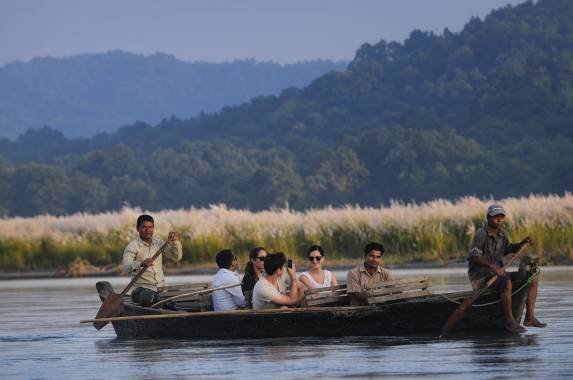
Today is dedicated to discovering the wildlife of Nepal and exploring the Chitwan jungle. In the morning, take a traditional dugout canoe made from a single tree trunk along the Rapti River, our naturalist guide helping us to spot birdlife and crocodiles as we gently cruise on the water.
After lunch, head out from our resort on a jeep safari through Chitwan National Park. Keep your eyes peeled for several deer species, wild boars, endangered one-horned rhinos and the very rare Bengal tiger. Our certified guides are typically local to the park, often from the indigenous Tharu community, who have a long history of living in close harmony with the Chitwan wildlife. Their knowledge of the local ecosystem, animal behaviour and traditional practices makes them excellent nature guides.
This evening, we watch a traditional stick dance performance, an important part of Tharu culture. The dance is performed by members of the Tharu community, who use long sticks to create an engaging, energetic performance. It is believed to have originated as a means of protecting the Tharu communities from various threats, including wildlife and evil spirits, and is now a celebration of Tharu identity and a way to preserve and showcase their cultural heritage to visitors. Please note, the order we do activities is decided by the naturalist depending on local factors.
Accommodation: Green Mansion Resort (or similar)
You have the option to rise early and head out before breakfast for a bird-watching walk in the Baghmara Community Forest, around a five to 10-minute stroll from our resort, joined by a naturalist guide. Then, after a leisurely breakfast, we set off for the six-hour drive back to Kathmandu, arriving in the evening.
Our journey takes us out of the lowlands to travel once more alongside the Trishuli River, before arriving at the Himalaya foothills. Taking a Chinese-built road running parallel to the range, the journey slows as we pass through the hilly region. Our reward, however, is plenty of amazing views encompassing terraced farms, numerous villages and the adjacent Trishuli River.
Upon arrival in Kathmandu, we typically have time to refresh before dinner.
Accommodation: Royal Singi (or similar)
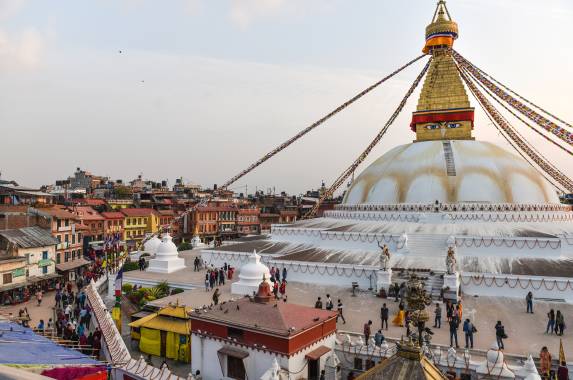
For those keen to see the highest mountain in the world, there is the option of an early morning Everest sightseeing flight from Kathmandu. This can be booked and paid for locally with help from your tour leader. Please note, it may not always be available due to weather restrictions.
Today is also your chance for sightseeing in the capital. A local guide escorts you on a city tour, visiting one of the largest Buddhist stupas in the world at Boudhanath, and the most important Hindu temple in the valley at Pashupatinath.
Accommodation: Royal Singi (or similar)
The trip comes to an end after breakfast. However, if you’d like a little more time to explore Kathmandu or the surrounding valley region, speak to your sales representative about extending your stay.
The trip finishes after breakfast. Those travelling on the group flights to London will transfer to the airport for their flight back to the UK.
Ascents, descents and distances: All ascents, descents and distances listed in the daily itinerary have been measured by our local partners or tour leaders, in many cases with satellite-based mapping software. However, different GPS measuring devices can give differing results, particularly on winding paths or in mountainous terrain. Measurements stated throughout these Trips Notes are given to help you understand the types of terrain and distances you will encounter. Timings stated will vary depending on the pace of your group.
Accommodation
Himalayan lodges, jungle resort and hotels

On this walking and wildlife trip to Nepal, we enjoy a broad range of accommodation, including two hotels, excellent mountain lodges in the Annapurna foothills, and a jungle resort in Chitwan.
Kathmandu: Royal Singi (nights 1 and 11-12)
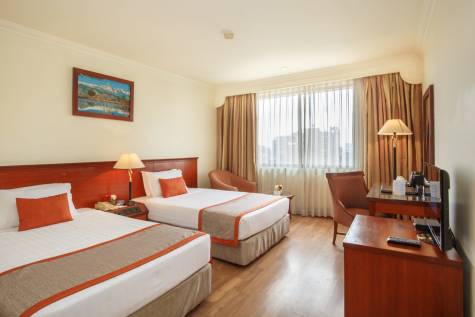
The Royal Singi, a three-star hotel, has been welcoming our groups for more than two decades. The name is inspired by the Snow Lion, a mythical creature in Tibetan Buddhism, which represents immense joy, positivity, delight and comfort. The hotel embraces the name with a restaurant, bar, outdoor courtyard, and complimentary wifi throughout. There’s also an Exodus desk in the lobby and an Exodus representative is usually available daily in the mornings and evenings. The Royal Singi is well located near the Thamel district, close to banks, restaurants, shops and attractions.
Annapurna: Mountain Lodges of Nepal (nights 2-6)
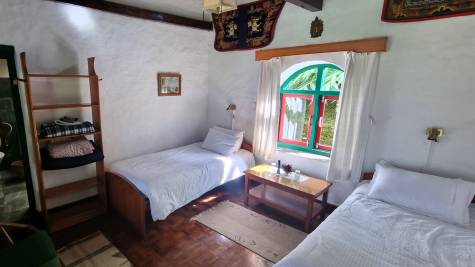
In the Annapurna foothills, we stay in excellent lodges with magnificent views of iconic peaks. These are run by Mountain Lodges of Nepal and are considered the finest accommodation in the area. Interior décor is in a traditional Nepalese Gurung style, local to the region. Expect a welcome drink on arrival and, in your room, down jackets, warm hats and gloves, and Crocs to keep you extra comfy.
Pokhara: Hotel Pokhara Village (nights 7-8)
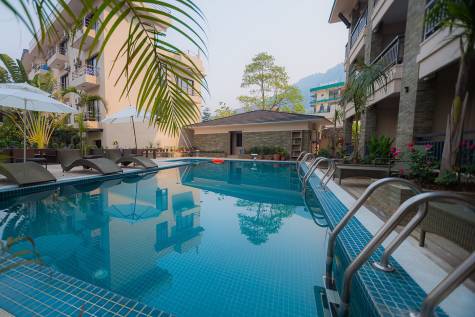
Pokhara Village is ideally located close to Phewa Lake, the star attraction in the city, where you’ll find a viewpoint with vistas over the waters and mountains. The hotel itself has a swimming pool and garden for post-trek relaxation, plus a restaurant and bar.
Chitwan: Green Mansion Resort (nights 9-10)
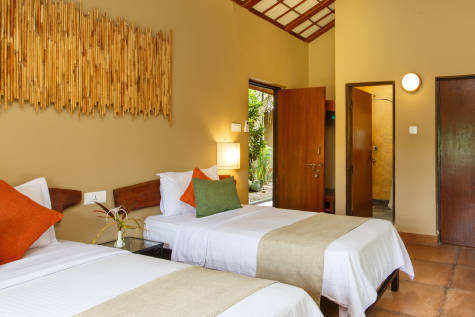
On the edge of a community forest, Green Mansions offers traditional cottages encompassed by nature. The highlight may well be their in-house team of naturalists, who bring the landscape to life with their expertise. Other pluses include a pool with half-sunken loungers and a multi-cuisine restaurant where dishes include produce from the hotel garden.
Worth knowing
- If you require additional accommodation in Kathmandu or Pokhara, either before or after the tour, we can book this for you (subject to availability), please enquire with your sales representative.
- If you prefer your own room, we offer a single supplement for all nights including during the trek; however, single rooms may be limited in the mountain lodges and twin share might be required (subject to availability).
Single supplement from £ 970
Food & Drink
All breakfasts, seven lunches and seven dinners are included. Allow approximately 3,000-5,000 rupees (US$22-US$38) per day for meals not included in Kathmandu and Pokhara.
Dhal bhat is the staple diet in Nepal and comes in many different forms but generally comprises curried lentil dhal and meat or vegetables, rice, and a pickle/chutney. Another popular snack is momos, a Nepalese dumpling filled with meat or vegetables.
Meals in the lodges range from traditional Nepalese food to Chinese and Western dishes. The food is good quality and usually served buffet style. You are provided with safe drinking water on trek and in Chitwan.
If you have a gluten-free diet, we strongly recommend you bring extra food and snacks with you to supplement the food on trek as there will be little variety available to you, particularly for breakfast. Even some soups are from powder/packets and contain gluten.
Drinking water
Staying hydrated is important when undertaking any physical activity; on this trip, it is generally recommended to carry a 33floz (one litre) water bottle and drink at least 67floz (two litres) per person per day.
However, we strongly encourage you not to buy bottled water on trek as this contributes to the growing problem of plastic pollution in the trekking areas of Nepal.
You can top up water bottles at tea breaks and lunch stops along the way – some villages have water stations selling UV-treated drinking water for about 50 rupees (US$0.40) per litre.
Alternatively, all teahouses provide free cold water. This should not be drunk untreated, so we recommend you bring a reusable bottle/water bladder (ideally two) and use an effective form of water treatment. Talk to an outdoor retailer for the latest advice as technologies are improving all the time.
Exodus has partnered with Water-to-Go, a filtration system that eliminates more than 99.99 percent of all microbiological contaminants from any non-saltwater source – visit Water-to-Go for more information. Exodus customers can claim 15 percent off their first order and, better still, 15 percent of the purchase value will be donated to the Exodus Travels Foundation. These bottles filter the water as you drink through the spout may not be the most efficient while on the go on a trek.
Transport
We use a private air-conditioned minibus for the main road journeys and private hired jeeps in Chitwan National Park. We also take an internal flight from Kathmandu to Pokhara. All internal flights in Nepal are subject to weather conditions; if the flight is cancelled due to fog or bad weather, for example, travelling by road will be unavoidable.
Please read our note on flight safety in Nepal in the Is This Trip for You? section of our Trip Notes.
The trekking portion of the trip requires you to walk between each lodge. Other forms of transport may be available along the route (horses, jeeps etc) but Exodus is not able to take responsibility for the safety or cost of any transport that you choose to take even if provided with the assistance of our tour leader or staff.
Weather & Seasonality
The main trekking season in Nepal is from October to mid-May when daytime temperatures at most altitudes are generally comfortable for walking, the sky is clear much of the time, and rain and snow are occasional occurrences. Daytime temperatures vary from 15C to 30C (59F to 86F).
However, different seasons offer different advantages for trekking.
Mid-September to November: Daytime temperatures are up to 25C (77F). Skies are usually clear and days on trek are sunny and mild with clear mountain views. Nights are colder with temperatures dropping to about 5C (41F).
December to end of February: Despite the cooler conditions, this is an ideal time to trek in Nepal. For this particular trip, December is the best month as the skies are usually very clear, the days are sunny, and the mountain views are at their best. Early mornings and evenings are cold with temperatures down to about 5C (41F), but days are sunny with temperatures up to 22C (72F). The trails are also much less busy. Chitwan is cold in the early mornings and evenings but pleasantly warm in the daytime.
March to May: Temperatures are warmer in general but haze often builds in the afternoons and there can be rain. Temperatures rise to 30C (86F) and above in Chitwan and in Kathmandu. On trek, the days are hot (up to 25C/77F) and nights are a bit cooler. Flowers bloom in this season and this is one of the reasons people chose to trek at this time.
In any mountain area, the weather is never wholly predictable; you should be prepared and equipped to deal with any differences in weather beyond the conditions described above.
Joining Instructions
Key information
Start hotel: Royal Singi, Lal Durbar, Kamaladi, Kathmandu, 44600, Nepal
Phone: +977 1-4524191
Recommended arrival time: You can arrive at any time today. There will be a welcome briefing in the evening, but if you miss it the leader will update you separately
Airport: Kathmandu Airport (KTM)
Getting to the start hotel
The start hotel is approximately 10 minutes’ drive from the airport. We provide free arrival transfers to the start hotel from the airport for all.
If you would like further information on joining this trip, please speak to your sales representative.
Catching your return flight
We provide free departure transfers for all to Kathmandu Airport (KTM) from the end hotel.
Please note, unless specified otherwise, the transfers will be to the start (or pre-tour) hotel and from the end (or post-tour) hotel and will be on the date on which the tour starts/ends; transfers to other hotels in the same city and/or on different dates may attract an extra charge. Transfers should be booked with your sales representative at least two weeks before the tour starts.
Full joining instructions including local emergency numbers will be sent to you as part of our Final Joining Instructions. If you do not receive these at least a week before departure, or require them earlier please contact our office or your travel agent.
Location start: Kathmandu
Location end: Kathmandu
What To Take
Essential Equipment
Please note, many Nepalis wear traditional clothing, so we suggest you dress conservatively. T-shirts are preferable to sleeveless tops and it is not advisable to wear tight or revealing clothing. Long shorts (knee length) are acceptable for women but preferably not tight fitting.
For the trekking part of this trip, you are provided a trek pack by the mountain lodges. This includes a backpack, trekking pole, rain poncho and use of a trek duffle bag. A map, sun hat and cotton scarf, which you can keep, are also included. These will be brought to the trek briefing in Pokhara. Down jackets, warm hats and gloves and sandals are provided in each trek lodge bedroom for use during your stay.
You do not need a sleeping bag, sleeping mat or towel for this trip.
There is a left luggage store (free of charge) in the Kathmandu hotel. You can also leave luggage in Pokhara while on trek. Your leader will brief you in Kathmandu as to what is needed for each activity and where luggage can be left during the various activities on this trip.
When packing, please consider the quantities/volume of the items you bring, it’s recommended to decant larger toiletries into small reusable bottles to limit weight and volume, for example. Please limit your trek pack to 22lb (10kg) per person. Your tour leader will weigh each pack before departing and may ask those with overweight bags to remove non-essential items and leave in Kathmandu/Pokhara.
In addition to your normal daily clothes, you need:
- Two passport photos for your trekking permit (plus an additional one if getting a visa on arrival in case the electronic machines are down)
- Lightweight walking boots (worn in)
- Backpack for the day
- Sunhat, sunglasses, sunscreen
- Mosquito repellent
- Several pairs of walking socks
- Tracksuit or thermals for the evening
- Mid-layer (fleece)
- T-shirts/shirts/base layers
- Lightweight trousers (pants)
- Light cotton clothes in dull colours for Chitwan
- Shorts
- Refillable water bottle/water bladder
- Hand washing gel
- Dry bags to line backpack and for packing clothing in the backpack
- Small personal first-aid kit
- Rain jacket and rain trousers (pants). The rain ponchos on offer at the trek lodges are only showerproof so you may wish to bring your own waterproofs
- Biodegradable mini toiletries for the trek (please do not bring full size items and limit to essentials)
Donations
If, while packing, you find space in your bag then you may be interested in donating to one of Exodus’ projects. Exodus supports a porter clothing bank in Kathmandu, as well as children in local schools in Kathmandu and various villages, and a care home in Kyanjin Gompa in the upper part of the Langtang Valley. If you have any old walking gear, this can be donated to porters. Similarly, any warm clothing or blankets would be appreciated by the care home – please leave these items with your tour leader or at the Exodus desk at the Royal Singi hotel. Books, stationery, games, warm clothes/underwear etc suitable for children aged five to 18 years should be taken to the Ambassador Garden Home in Thamel and given to Prakash Lammichanne. Your tour leader can assist with arranging this.
Optional Equipment
- Trekking pole(s)
- Gaiters (after the rain, leeches can be expected in the forest sections of the trek)
Practical Information
Passport
Your passport must be valid for at least six months when you submit your application for a visa. You should also ensure your passport is up to date, valid for the entire length of your stay and that you have completed the emergency contact details page inside your passport.
Visa
Nepal
You can obtain your visa in advance or on arrival. The Immigration Department of Nepal has suspended visas on arrival for certain nationalities – please check if this applies to you with your nearest embassy or consulate.
Visa in advance
Apply for this through your local consulate or embassy. Further details on this option can be found here:
- For UK passport holders: https://uk.nepalembassy.gov.np/visa/
- For US passport holders: https://us.nepalembassy.gov.np/tourist-visa/
When applying for your visa in advance, the Nepalese government has an online application system (see links above for more info), but it is currently only accepting payments through Nepalese payment channels. Once the online form is completed, the applicant is required to print out the form and either send it, together with the passport, to the embassy, or attend in person.
Visa on arrival
- When you arrive at Tribhuvan International Airport in Kathmandu, there will be three lines. If you have already secured your visa, go straight to the Immigration line. If not:
Fill in a tourist visa form at the electronic kiosks. After inserting your passport, the machine will automatically fill out an application form, take an electronic photograph of you and print a paper slip. If the machine won’t read your passport, complete the details manually using the touchscreen. We recommend taking a passport photo with you just in case.
Top tip: This process can be completed through the online immigration portal (click ‘Visa On-Arrival’) within 14-days prior to arrival in Kathmandu, helping you to avoid lengthy queues at the kiosks when you come through immigration – ensure you print and bring the confirmation with you. If you have completed your visa on arrival form in advance, go directly to the visa fees counters with your printed confirmation and skip the kiosk queues. - Proceed to the visa fees collection counter and pay the visa fee (in cash, if possible). Make sure to keep the receipt. Card payments are not always possible, so paying in cash is easiest, most currencies are accepted but US dollars are preferred.
- Go to the relevant immigration desk and present your tourist visa form, payment receipt and passport to obtain your 15-, 30- or 90-day visa stamp. Please check you have been given the correct visa duration.
Vaccinations and Health
There are no mandatory vaccination requirements. However, recommended vaccinations include polio, tetanus, diphtheria, typhoid, hepatitis A.
The risk of malaria is present in certain regions only (such as Chitwan); you may wish to consult your GP or travel health clinic for further advice. The risk is highest in the low lying southern ‘terai’ districts bordering India.
A yellow fever certificate is only required if travelling from a country with risk of yellow fever transmission or for travellers having transited for more than 12 hours through a country with risk of transmission.
Dengue fever is a known risk in Nepal. It is a tropical viral disease spread by daytime biting mosquitoes. There is currently no vaccine or prophylaxis available; therefore, the best form of prevention is to avoid being bitten. There was a dengue outbreak in September 2022 with a number of cases recorded in Kathmandu and the Kathmandu Valley. We therefore recommend you take extra precautions to avoid mosquito bites such as wearing full length trousers, long sleeves and applying insect repellent during the day as well as at dawn and dusk.
Altitude is not a factor of consideration on this trip as all activities take place below 6,560ft (2,000m).
Ticks are known to be present in this region and can carry Lyme disease, tick-borne encephalitis and other diseases. Please take care to protect yourself. You can read more about ticks here.
Local Time
Nepal's time zone: Asia/Kathmandu (UTC +05:45)
Electricity
Nepal's electricity: Plug types C (two round pins, European standard), D (three round pins) and M (three round pins) – 230V, 50Hz Mains electric 'load shedding' (planned temporary power cuts) occur regularly throughout towns and cities in Nepal. On teahouse treks, the majority of lodges now have electricity and charging facilities in the communal areas for batteries, for a fee. Battery life can be affected by cold; lithium batteries are best.
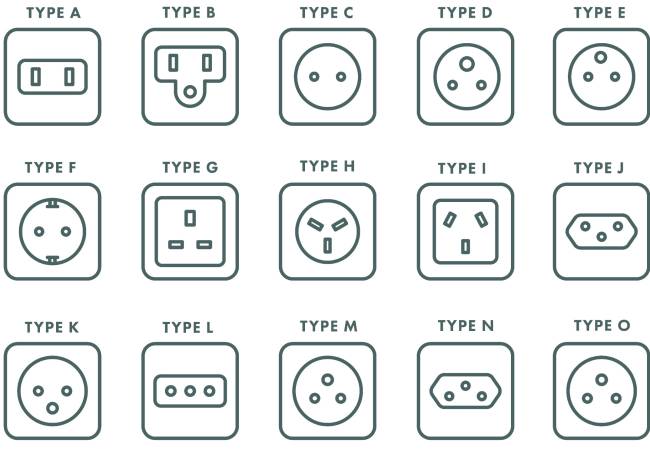
Money
Nepal's currency: Nepalese rupee (NPR) It is illegal to import or export rupees, but foreign currency is not limited, provided it is declared on arrival. Keep your change receipts, as you will need them if you want to change rupees back into hard currency at Kathmandu airport.
ATM Availability
There are ATMs in Kathmandu and Pokhara. Please do not rely wholly on ATMs as many are broken or run out of money. Some banks have a withdrawal limit equivalent to about US$120 per time but there is usually a transaction fee, if you need to withdraw more money than this you should look for another ATM with a higher limit (others have a maximum withdrawal limit equivalent to about US$360 per time).
Credit cards are accepted in many of the larger shops and restaurants in Kathmandu and Pokhara.
Extra Expenses & Spending Money
We recommend taking your personal spending money in cash (US dollars, British pounds or euros can all be changed easily). Marked, torn or damaged notes may not be accepted. Please remember, £50 notes, Scottish or Irish currency cannot be changed in Nepal. Cash can be changed easily at the airport on arrival in Kathmandu or at money changers in the Thamel area of Kathmandu. Hotels in Nepal can also change up to US$300 per person. Our staff will advise you on how much money to take with you on trek.
You need to withdraw/exchange enough money in Kathmandu to last the duration of your trek – to cover snacks, drinks, tipping and other incidentals. It is a good idea to carry spare cash on the trek in case of an emergency. Carrying cash is unavoidable so we suggest splitting it up into a few different places – but remember to keep track of how much you have stashed where.
Optional excursions
Several optional tours and activities are available from Kathmandu and Pokhara.
An optional Everest sightseeing flight is available on your free day (weather permitting) from around 27,750 rupees (US$210) per person – subject to change. It’s worth checking the weather and seat availability on the flight with your leader before booking. Some fuller flights may mean you won’t be allocated a preferred window seat and have poor visibility of the Everest range. Anyone taking an internal sightseeing flight in Nepal should pay attention to the statement ‘Flying in Nepal’.
Tipping
Tipping is customary in Nepal and usually expected. Tipping can often be an awkward affair, especially when in an unfamiliar country where you are not sure when or how much to tip. As such, your tour leader will usually offer to arrange and look after a group tipping kitty, which will be used to tip hotel porters, local guides, assistant guides, porters, and the drivers. Your leader will suggest how much to contribute, depending on group size, but a rough guideline is provided below.
A tip for the leader is at your discretion and separate to the amount they will suggest for the other staff. We suggest you send an envelope around the group at the end of the trip, and you can put in what you like and give to the tour leader on the last evening.
The following are guideline amounts received by each staff member from the group as a whole.
- Tour leader: 32,500-36,000 rupees (usually tipped on the last night in Kathmandu)
Your trekking crew (tips are usually given on the last evening of the trek in Dhampus)
- Trekking guides: 21,000-26,000 rupees for each guide
- Trek porters: 12,000 rupees for each porter
General tipping guidelines:
- Drivers:
- Pokhara to/from Biretanthi (per each-way transfer): 500 rupees in total from the group
- Pokhara to Chitwan: 1,500 rupees in total from the group
- Kathmandu to/from Chitwan (per each-way transfer): 1,500 rupees (US$10-12) in total for the journey
- Naturalist Guide (Chitwan): 1,350 – 2,000 rupees (US$10 – 15) per passenger, per day
- Hotel porters: 150 rupees (US$1-2) each time for each room
- Teahouses and lunch stops on trek: it’s customary to round your bill up to the nearest 50 rupees or 100 rupees
- Restaurants: 10% of the bill if good service
To help budget for the tips, generally there will be one member of trek staff (leader/guide) for every eight members of the group. You also have one porter for every two group members to carry your luggage. If you are unsure on how much to personally budget, check with your tour leader when you arrive in Kathmandu. It is preferable to give tips in local currency where possible.
Sustainability and Impact
As a certified B Corp, we’re on a mission to improve our social and environmental impact across all our adventures.
We do this through our innovative Thriving Nature, Thriving People plan.
This ‘nature positive’ approach is designed to help nature and communities thrive in harmony though practical solutions, such as reducing carbon and waste on our trips, supporting conservation projects through the Exodus Adventure Travels Foundation, and rewilding 100 square metres for every Exodus traveller.
Important Information
Optional activities and excursions
If you would like to join an optional activity or excursion outside those listed in the itinerary, your leader may be able to assist with selecting a provider. However, Exodus has not assessed the safety standards of activities or excursions that are not listed in the Trip Notes. All optional activities or excursions are undertaken at your own risk.
Important Information
Your safe participation
When booking this trip, you should be confident in your ability to participate in all activities described in these Trip Notes. If you have any doubt about your suitability, please call us and ask to speak to one of the experts on this itinerary.
Although our leaders are well trained to deal with different capabilities, if they have any concerns about someone’s ability to safely take part in an activity, or their impact on other people’s enjoyment, we authorise them to take necessary action which, in some circumstances, may involve asking someone to miss that activity.
By booking this trip you agree to our Booking Conditions which clearly state that our leaders have the authority to do this. In these rare instances we will ensure anyone sitting out is safely provided for and offered alternative options where possible. Refunds will not be provided for activities missed and customers may be liable for additional costs incurred.
Seatbelts
All vehicles used by us should be equipped with working seatbelts, except where approved by us based on the vehicle type or journey. Wherever seatbelts are available, we require our customers to use them for their own safety, even where it may not be a legal requirement.
How to Book
- Check availability: Go online to check availability, or contact us by phone or email.
- Secure your place: You can provisionally hold a place on this trip, usually for between three and seven days.
- Complete your booking and payment
When you’re ready to book, go to our website for online bookings, book over the phone or you can complete a booking form (available online or on request by calling us). We accept all major credit and debit cards, or you can pay be cheque.
After booking
You will receive your booking confirmation letter and invoice, which includes extra information and guidance about your travel arrangements.
Full joining instructions, including local emergency numbers and details of how to reach the start point, will be sent to you approximately two to three weeks prior to departure. If you do not receive these at least a week before departure, or require them earlier, please contact our office or your travel agent.
Trip Note validity
These Trip Notes are valid from the “Current as” date on page one. They will occasionally be updated after booking and before departure; if there are any updates that significantly impact the inclusions or itinerary, customers will be written to separately. They will also receive a link to the most up-to-date Trip Notes with their Final Joining Instructions before travelling.
The information in these Trip Notes is given in good faith. Where differences exist between the Trip Notes and our current brochure or website, the Trip Notes supersede the brochure and website. All holidays can be subject to unexpected changes; to enjoy them you should be prepared to be flexible where necessary. Occasionally, it may not be possible to follow the itinerary as planned. This may be for a variety of reasons – climatic, political, physical or other. In these circumstances we will make the best-possible alternative arrangements that maintain the integrity of the original itinerary.
Licensing
Exodus is fully licensed and bonded as a tour operator. We hold Air Traffic Organisers Licence (ATOL) number 2582, issued and bonded with the Civil Aviation Authority (CAA). We are also bonded to the International Air Transport Association (IATA) and we are members of the Federation of Tour Operators (FTO) and ABTA – The Travel Association. This means you can book your Exodus holiday with confidence, as all money paid to us for your trip is fully protected.